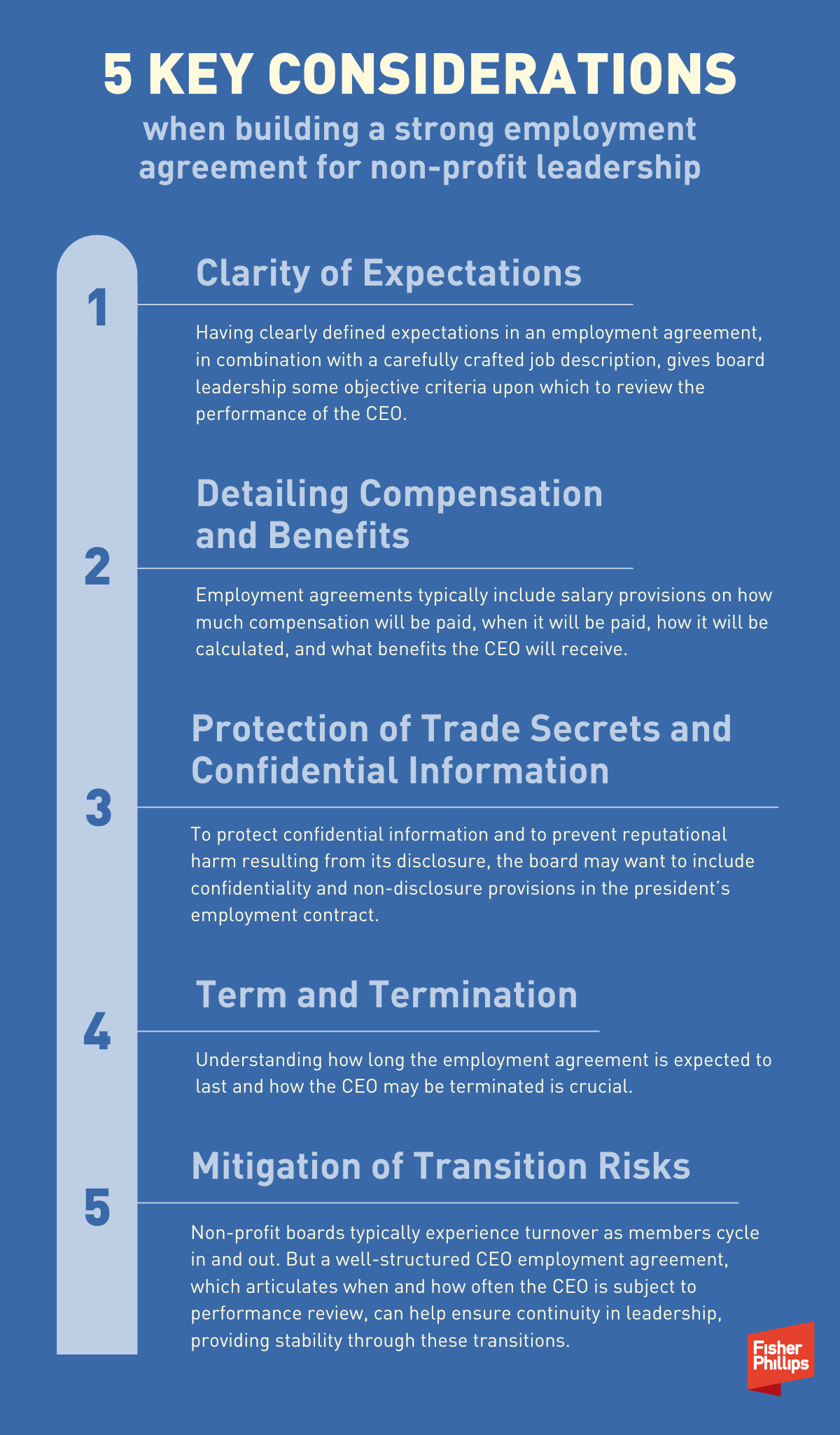Now May be the Time to Ask Whether Your Non-Profit’s Top Executive Should Have a Contract – 5 Key Considerations
Insights
2.11.25
In a time where headlines are dominated with executive orders and political shake-ups, non-profit boards cannot afford to be distracted from leadership decisions that matter most. Your CEO plays a pivotal role in guiding your organization through change – so why leave that relationship undefined? Now may be the time to ask whether your nonprofit’s top executive should have an employment agreement. Getting it right could mean the difference between a smooth transition and chaos in a pivotal moment. There are other important considerations for building a strong employment agreement for non-profit leadership. Below are five important considerations to consider when making this important decision.
1. Clarity of Expectations
Having clearly defined expectations in an employment agreement, in combination with a carefully crafted job description, gives board leadership some objective criteria upon which to review the performance of the CEO. Examples of specific responsibilities and expectations which may be included in an employment agreement for a non-profit CEO are:
- Development and Maintenance of a Crisis Management Plan. A crisis can disrupt a non-profit’s operations and threaten its public image. What does the board expect to happen in the event of an internal or external crisis? Is the CEO expected to develop and regularly update a written plan to manage crises?
- Governance Collaboration. What will the CEO’s relationship with the board be? Are they expected to attend all board meetings? When and under what circumstances are they expected to collaborate with the board chair or other board leadership?
- Fundraising and Financial Stewardship. Does the board have specific expectations that the CEO will plan and implement short and long-term budgets and meet specific fundraising targets? What will the president’s role be in recruiting and meeting with potential large donors?
- Leadership and Professional Development. Is the CEO expected to develop their leadership skills through external means like taking courses or working with executive coaches? Does the board have expectations around the CEO’s development of senior leadership who report to them?
2. Detailing Compensation and Benefits
Employment agreements typically include salary provisions on how much compensation will be paid, when it will be paid, how it will be calculated, and what benefits the CEO will receive. But there are specific concerns that a non-profit organization should think about.
- If the new president forfeited compensation by leaving a prior position, the board may want to grant a one-time signing bonus.
- The board may also want to consider the merits of a retention bonus if the CEO stays in the role for a specified time.
- The board should also decide if performance-based bonuses are on the table and, if so, how they will be measured and how often they will be given. You should carefully consider metrics that may include meeting fundraising goals, working within a specific budget, growing reserve funds, or other metrics central to the mission of the organization.
- Sometimes compensation in the non-profit sector competes against the for-profit sector, making recruitment of other employees a challenge. The board may want to give the CEO a bonus if they meet certain recruitment and retention goals for organization staff members.
3. Protection of Trade Secrets Confidential Information
During their employment, a president may have access to sensitive, non-public information. Examples of this type of confidential information in the non-profit sector may include membership lists, donor information, fundraising and strategic plans, and intellectual property rights. To protect the information and to prevent reputational harm resulting from its disclosure, the board may want to include confidentiality and non-disclosure provisions in the president’s employment contract. These terms would define the specific information that needs to remain confidential and would outline the parameters for the parties’ use of the confidential information.
4. Term and Termination
Understanding how long the employment agreement is expected to last and how the CEO may be terminated is crucial.
Sometimes attracting the best talent may be a challenge. Your organization may need to agree to a term of employment (five years, for example) to get the right person to agree to take the job. In any case, at the expiration of the term the table is set for the board to review the agreement and decide whether the needs of the organization have shifted and new terms are appropriate.
Providing for a specific term of employment should be balanced, however, by clear expectations about why and how a non-profit board may elect to terminate the employment of a CEO. Most executive contracts are “at will,” meaning the board can sever the relationship at any time, for any reason. But the parties may agree to handle termination differently if it is done “for cause” or not. Having pre-established severance terms may make sense for the organization and mitigate future legal disputes.
5. Mitigation of Transition Risks
Non-profit boards typically experience turnover as members cycle in and out. But a well-structured CEO employment agreement, which articulates when and how often the CEO is subject to performance review, can help ensure continuity in leadership, providing stability through these transitions.
By establishing clear terms for the CEO’s role, an employment contract can help safeguard the organization’s mission and vision. If the agreement thoughtfully reinforces the organization’s long-term strategic goals, the contract can help ensure that shifts in board leadership do not derail the organization’s mission and vision.
As discussed above, employment agreements can outline transition protocols, which can help ensure an orderly handoff if the CEO departs, rather than leaving the process for an incoming board to figure out. Clearly defined severance terms can protect both the CEO and the organization from costly disputes.
Conclusion
At the end of the day, a formal agreement is not required to establish an employer-employee relationship between a non-profit organization and its president, but these agreements are widely used for high-level executives and key employees. Whether your organization has a seasoned leader or is preparing for transition, now may be the time to evaluate how a well-structured employment agreement can protect both the organization and its leadership in a time of change and uncertainty.
If you have questions, contact your Fisher Phillips attorney or the author of this Insight. We’ll continue to monitor developments that impact the workplace and provide updates as warranted. Make sure you are subscribed to Fisher Phillips’ Insight System to ensure you receive the latest news directly to your inbox.
Related People
-
- Erin Gibson Allen
- Of Counsel

